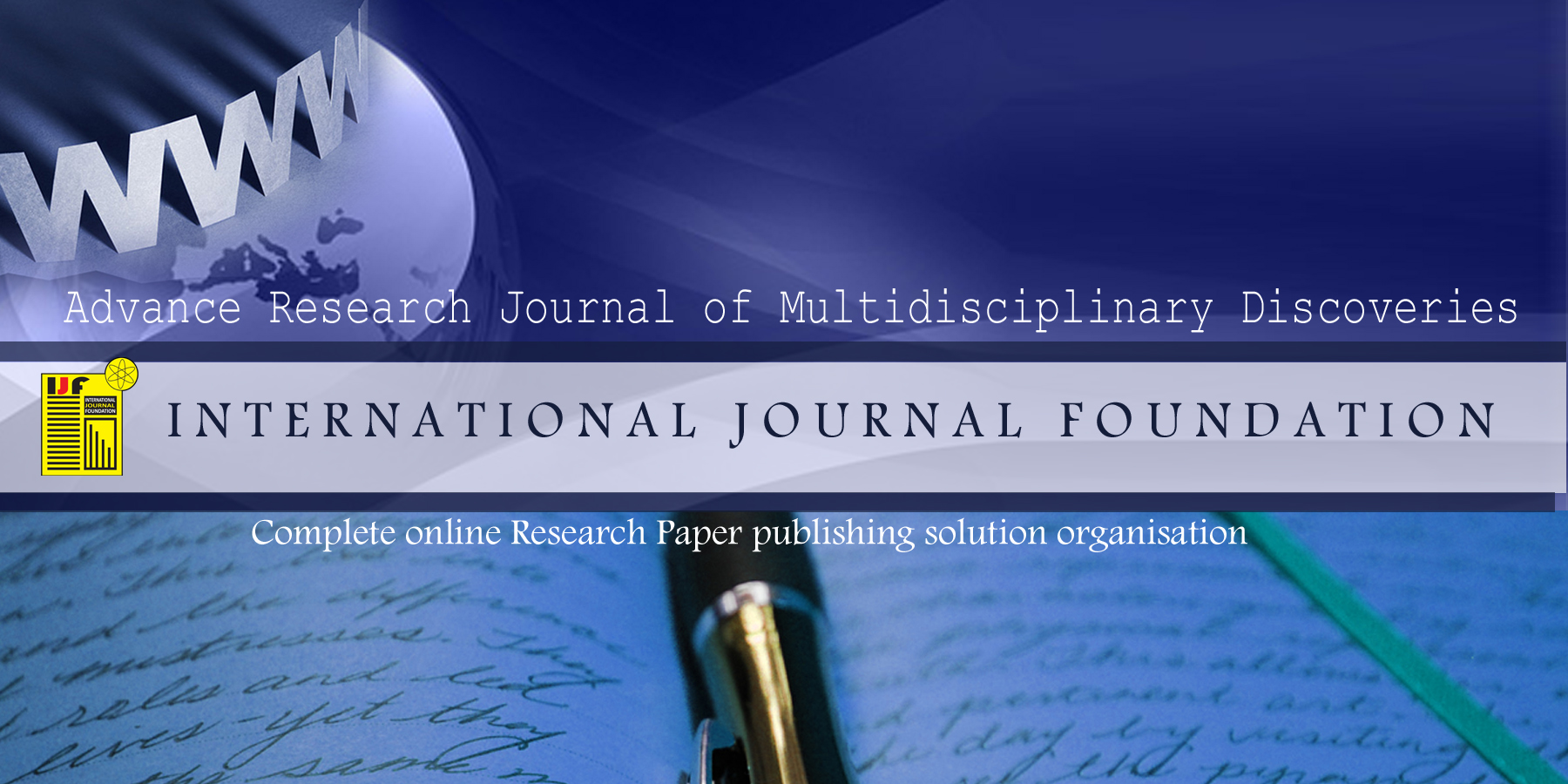2021
NOVEMBER 2021/ Vol.67.0/ Issue-I
CATEGORY : Research Topic on Education [ Original Research Article ]
| SL.No. | Detailed information of the published article |
| 1 | Manuscript Title : Design Thinking Approach in Teaching Physics. Author’s Name : Nerrie E. Malaluan1 , Joy N. Landicho2 Article Type : Original Research Article Country from : PHILIPPINES Date of Publication: 20-01-2022 Journal Name : Advance Research Journal of Multidisciplinary Discoveries [ ISSN : 2456-1045 ] Article Identification : Vol. 67.0/Issue-I/Chapter-I/Page – 01-09 [NOVEMBER-2021 EDITION ] Article Code : EDU-V67-I1-C1-NOV-2021 Status : Officially published Publisher : International Journal Foundation Download PDF : Full article (Pdf) Doi No : 10.5281/zenodo.5873526 —————————————————————————————————————————— ABSTRACT: This study aimed to determine the effectiveness of design thinking approach in teaching physics to Grade 8 students of Padre Vicente Garcia Memorial Academy, Inc. during the school year 2018-2019. It determined the students’ levels of performance in the pre-test and post-test in the experimental and control groups after which test results were compared. click here KEYWORDS: academic performance, design thinking approach, experimental, innovation, physics learning. |
CATEGORY : Research Topic on Medical Science [ Original Research Article ]
| SL.No. | Detailed information of the published article |
| 2 | Manuscript Title : The Health Belief Model (HBM) implementation to flood preparedness. Author’s Name : Nur Laily1 ,Anggun Wulandari2 , Lia Anggraini3 ,Farid Ilham Muddin4 Article Type : Original Research Article Country from : INDONESIA Date of Publication: 20-12-2021 Journal Name : Advance Research Journal of Multidisciplinary Discoveries [ ISSN : 2456-1045 ] Article Identification : Vol. 66.0/Issue-I/Chapter-I/Page – 01-06 [OCTOBER-2021 EDITION ] Article Code : MDS-V66-I1-C1-OCT-2021 Status : Officially published Publisher : International Journal Foundation Download PDF : Full article (Pdf) Doi No : 10.5281/zenodo.5791630 —————————————————————————————————————————— ABSTRACT: One of the natural disasters that has a major impact to health is a flood. Community preparedness is part of disaster risk reduction. Previous research has found that there is a widely developed belief in society about disasters, namely, first, that disasters are unavoidable and thus nothing to worry about. Second, the health sector will manage risk, and disaster risk is not a problem. click here KEYWORDS: Health belief model, perceived susceptibility, perceived severity, perceived benefits, perceived barriers, self-efficacy, disaster preparedness. |
CATEGORY : Research Topic on Medical Science [ Original Research Article ]
| SL.No. | Detailed information of the published article |
| 3 | Manuscript Title : The role of young adults on preparedness and behavioral responses on flood disaster risk in the urban-rural area of South Kalimantan Province. Author’s Name : Vina Yulia Anhar, Ihya Hazairin Noor, Farid Ilham Muddin, Muhammad Azmiyannoor, Zulfa Emelda Article Type : Original Research Article Country from : INDONESIA Date of Publication: 20-11-2021 Journal Name : Advance Research Journal of Multidisciplinary Discoveries [ ISSN : 2456-1045 ] Article Identification : Vol. 66.0/Issue-I/Chapter-II/Page – 07-13 [OCTOBER-2021 EDITION ] Article Code : MDS-V66-I1-C2-OCT-2021 Status : Officially published Publisher : International Journal Foundation Download PDF : Full article (Pdf) Doi No : 10.5281/zenodo.5791644 —————————————————————————————————————————— ABSTRACT: The worst flood disaster in South Kalimantan Province happened in the early 2021. 10 out of 13 districts/cities are affected by the flood. Therefore, it is needed to conduct a study that resulting in data as an evidence base in designing the program of community empowerment in the phase of disaster preparedness. click here KEYWORDS: Flood, preparedness, behavior, young adult, urban rural. |
CATEGORY : Research Topic on Education [ Original Research Article ]
| SL.No. | Detailed information of the published article |
| 4 | Manuscript Title : Shared finance based on block-chain: Benefits and risks Author’s Name : Gang Chen1* & Yede Huang2 Article Type : Original Research Article Country from : CHINA Date of Publication: 24-10-2021 Journal Name : Advance Research Journal of Multidisciplinary Discoveries [ ISSN : 2456-1045 ] Article Identification : Vol. 64.0/Issue-I/Chapter-I/Page – 01-05 [AUGUST-2021 EDITION ] Article Code : EDU-V64-I1-C1-AUG-2021 Status : Officially published Publisher : International Journal Foundation Download PDF : Full article (Pdf) Doi No : 10.6084/m9.figshare.16863070 —————————————————————————————————————————— ABSTRACT: The establishment and operation of the shared finance center, the main application of block-chain technology in finance, has brought great convenience to the finance sector. Various enterprises in the group can share financial information in real time through the shared finance center, and the function of finance for daily business support and strategic decision-making is increasingly strengthened. click here |
CATEGORY : Research Topic on Business Management [ Original Research Article ]
| SL.No. | Detailed information of the published article |
| 5 | Manuscript Title : Value at risk (VAR)-Non-parametric methodologies : An approach to the study and application Author’s Name : Adalmiro Álvaro Malheiro de Castro Andrade Pereira*1 Ângela Daniela da Silva Vaz 2 Eduardo Manuel Lopes de Sá e Silva 3 Article Type : Original Research Article Country from : PORTUGAL Date of Publication: 20-10-2021 Journal Name : Advance Research Journal of Multidisciplinary Discoveries [ ISSN : 2456-1045 ] Article Identification : Vol. 63.0/Issue-I/Chapter-I/Page – 01-11 [JULY-2021 EDITION ] Article Code : BM-V63-I1-C1-JULY-2021 Status : Officially published Publisher : International Journal Foundation Download PDF : Full article (Pdf) Doi No : 10.6084/m9.figshare.16821949 —————————————————————————————————————————— ABSTRACT: VAR (Value at Risk), is the maximum probable loss of a portfolio for a given level of confidence, within a specified time horizon. In Instruction No. 4/2008, Banco de Portugal defines Value-at-risk to be “the maximum expected loss that is not exceeded with a specific probability (confidence level) and for a certain period of time (detention period) “. There are several methodologies for estimating VAR, but they are divided into two large groups: non-parametric (Historical simulations and Monte Carlo simulations) and parametric, based on variance and covariancy. click here KEYWORDS: VAR; historical simulations; Monte Carlo simulations, finance portfolio. JEL: classification G32 |
N.B: We are still in the process of publication, more paper will be added shortly in this issue.
(i) To Publish your paper in our upcoming issue send your article directly at article.ijf@gmail.com
![]()
![]()
![]()
![]()
![]()

















